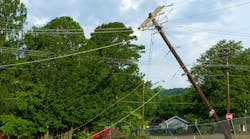With storms becoming more frequent and powerful, utilities have a renewed focus on improving grid reliability and restoring power as quickly as possible in the event of an outage. Delivering consistent and reliable power to customers is the top priority. When service is interrupted, the utility is expected know about it when it happens and to restore service quickly and efficiently.
Smart metering technology has added a useful data stream to help manage outages, but it is not a panacea. In fact, the current state of outage detection via the smart metering network is still an inferential, data-intensive exercise relying on how many affected meters can successfully transmit “last gasp” outage alarms to utility back end systems. Utilities are aware that the power is out, but don’t have a whole lot of timely insight beyond that. After the outage is over, information from smart meters also enables utilities to achieve operational improvements in their processes, but does little during the event to provide utilities with a useful and comprehensive picture of outage conditions.
This is where distributed analytics come into play, changing the outage management process by delivering timely and actionable intelligence in the context of the distribution network. This new generation of analytics can interpret the tsunami of raw power outage and restoration alarms to deliver an accurate, continuous feed of information to the utility on the state of their distribution grid. Ongoing, precise updates from the edge of the network enable crews to quickly and efficiently target their response during all phases of outage management operations.
The key is edge intelligence – combining location awareness on the grid with peer-to-peer communications at the edge of the network, this new generation of smart meters systematically and continuously evaluate the status of nearby meters and devices to quickly model and localize outage events and report reliable and actionable information back to the utility in near real time. The utility receives accurate summary information, including the scale and location of the outage, affected meters and affected transformers, in a compressed timeframe.
Analyzing outage data on the edge via peer-to-peer communications also helps utilities determine the most likely cause of the outage, which allows repair crews to arrive with the proper assets needed for faster restoration. In addition, analytics can identify duplicate alarms and momentary interruptions, and apply results to the grid topology to accurately determine outage extents, even in cases when a subset of outage and restoration notifications are received and eliminate false positives.
In addition, meters in and around the outage area can be pinged automatically to check their power status. Results are used to validate the initial assessment and continually update outage models during restoration. This continual, active examination of dynamically selected meters minimizes network traffic and effectively identifies problematic nested outages. This process continues until all endpoints are confirmed as restored.
With these capabilities, utilities can quickly and effectively target outage response and determine the scope of the outage. They can also continuously update and validate this information. Instead of interpreting anecdotal alarms, distributed intelligence provides utilities with actionable intelligence on the state of their distribution system all the way to the edge of the network. And that’s a big step forward to help restore power faster.


